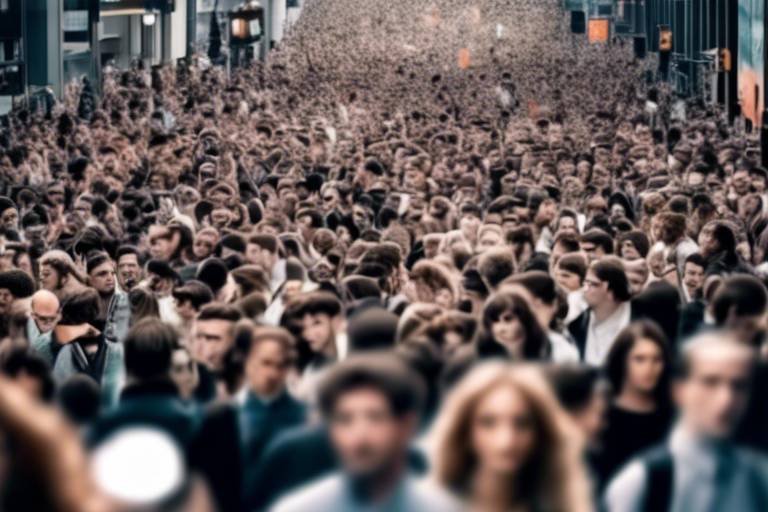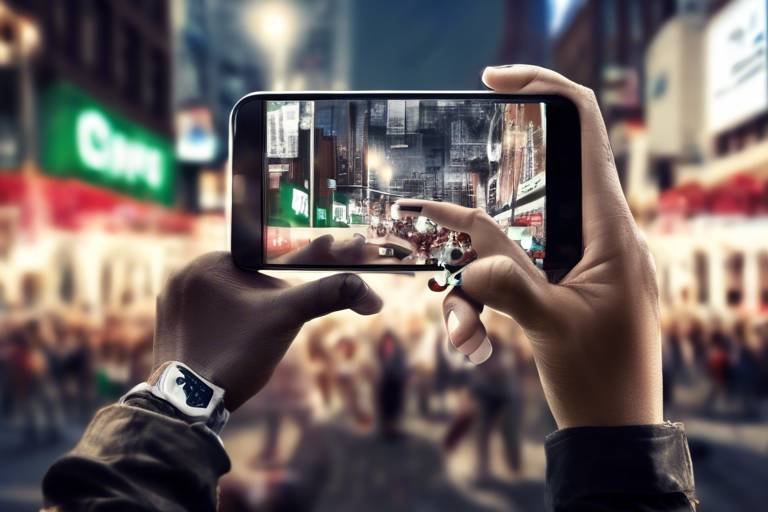The Impact of Social Media Algorithms on Future Content
In today's digital age, social media algorithms are the unseen puppeteers, orchestrating the way content is created, shared, and consumed. These algorithms are not just lines of code; they are powerful tools that shape our online experiences, influencing everything from the news we read to the videos we watch. Have you ever wondered why certain posts pop up on your feed while others fade into obscurity? This is the magic of algorithms at work, deciding what content deserves your attention and what gets lost in the shuffle. As we delve into the impact of these algorithms, it becomes clear that they are not only shaping the present but also paving the way for the future of content creation and consumption.
To truly understand the impact of social media algorithms, we need to take a step back and look at their evolution. Initially, social media platforms relied on simple chronological feeds, where the most recent posts appeared first. However, as user bases grew and content exploded, the need for more sophisticated systems became apparent. Algorithms evolved to prioritize content based on engagement metrics, such as likes, shares, and comments. This shift meant that not all content was created equal; some posts, regardless of their recency, received more visibility based on how well they resonated with audiences. Today, algorithms are complex entities that analyze vast amounts of data to deliver personalized content experiences, making them essential players in the digital landscape.
User engagement metrics are the heartbeat of social media algorithms. They dictate which content gets seen and which gets buried. But what exactly do these metrics entail? Engagement metrics include likes, shares, comments, and even the time spent on a post. When users interact with content, they send signals to the algorithm about what they enjoy. This feedback loop creates a cycle where content creators must constantly adapt their strategies to align with these metrics. For instance, if a video garners a high number of shares, it’s likely to be promoted further, while posts that fail to engage may be relegated to the depths of a user’s feed. Thus, understanding and leveraging these metrics is crucial for anyone looking to make an impact in the social media sphere.
As social media algorithms continue to evolve, content creators find themselves in a constant dance, adapting their strategies to meet the ever-changing preferences of these algorithms. It’s not enough to simply create content; creators must focus on quality, relevance, and engagement to enhance visibility and foster a deeper connection with their audience. This means producing content that not only captures attention but also encourages interaction. For instance, storytelling has become a powerful tool, allowing creators to weave narratives that resonate with their audience emotionally. Additionally, incorporating eye-catching visuals and calls to action can significantly boost engagement rates. Ultimately, the key to thriving in this algorithm-driven world lies in understanding what your audience values and delivering it in a compelling way.
Personalization is the secret sauce that makes social media algorithms so effective. By tailoring content to individual users based on their preferences, behaviors, and past interactions, algorithms create a unique experience for each user. This level of personalization enhances user satisfaction and retention, making it more likely that users will return to the platform. Imagine walking into a store where every item is handpicked just for you; that’s the power of personalization in social media. However, this also raises questions about privacy and data usage, as users may not always be aware of how their information is being utilized to curate their online experiences.
While algorithms can enhance user experience, they also raise significant ethical concerns. Issues of bias, misinformation, and mental health impact are at the forefront of discussions surrounding algorithmic transparency and accountability. For example, algorithms can inadvertently promote content that is sensationalist or misleading, leading to the spread of misinformation. Additionally, the pressure to conform to algorithmic preferences can contribute to mental health challenges among content creators and users alike. As the digital landscape evolves, it is crucial for platforms to address these ethical considerations and strive for greater transparency in their algorithmic processes.
Looking ahead, emerging trends in social media algorithms suggest a shift towards greater transparency and user control. Users are increasingly demanding to know how their data is used and how content is prioritized. The integration of artificial intelligence (AI) is also set to reshape the way content is delivered, allowing for even more sophisticated personalization. As algorithms become more advanced, they will likely evolve to better understand user intent and context, leading to a more enriching online experience. Businesses and creators will need to stay ahead of these trends to effectively engage their audiences and navigate the complex landscape of social media.
For businesses, understanding and navigating social media algorithms is essential for effective marketing. The algorithms dictate not only how content is distributed but also which audiences see it. Companies must develop innovative marketing strategies that leverage algorithmic insights to maximize their reach and impact. This might involve creating engaging content that encourages user interaction or utilizing targeted advertising to reach specific demographics. As the digital landscape continues to evolve, businesses that adapt to these changes will be better positioned to connect with their target audiences and drive meaningful engagement.
Finally, social media algorithms significantly influence community interactions and social dynamics. They shape how users connect, communicate, and form relationships within digital spaces. Algorithms can create echo chambers, where users are exposed primarily to content that aligns with their existing beliefs, potentially stifling diverse perspectives. However, they also have the power to foster connections between like-minded individuals, creating communities around shared interests. Understanding these dynamics is crucial for anyone looking to navigate the complex world of social media.
- What are social media algorithms?
Social media algorithms are systems that determine the visibility and distribution of content on social media platforms based on user engagement and preferences. - How do algorithms affect content visibility?
Algorithms prioritize content based on engagement metrics, meaning posts that receive more likes, shares, and comments are more likely to be shown to a larger audience. - What strategies can creators use to adapt to algorithms?
Creators should focus on producing high-quality, engaging content that resonates with their audience, utilizes storytelling, and encourages interaction. - Why is personalization important in social media?
Personalization enhances user satisfaction by tailoring content to individual preferences, making the experience more relevant and engaging.

The Evolution of Social Media Algorithms
Social media algorithms have come a long way since the early days of platforms like Facebook and Twitter. Initially, content was displayed in a chronological order, meaning users saw posts from their friends and followed accounts in the order they were published. This straightforward approach made it easy for users to catch up on their feeds but quickly revealed its limitations. With the exponential growth of users and content, the chronological model struggled to keep up, leading to the development of more sophisticated algorithms.
As social media platforms expanded, they began to implement algorithms that prioritized posts based on various factors. This shift was not merely a technical upgrade; it was a fundamental change in how users interacted with content. Algorithms started to analyze user behavior, engagement patterns, and preferences, allowing platforms to curate feeds that were more personalized and relevant. For instance, Facebook introduced the "EdgeRank" algorithm, which considered factors like user interactions, the type of content, and recency to determine what appeared in a user's news feed.
Fast forward to today, and we see a complex web of algorithms at play across different platforms. These algorithms use machine learning and artificial intelligence to continuously adapt and improve based on user interactions. They are now capable of predicting what content a user is likely to engage with, often before the user even realizes it. This predictive capability has transformed the user experience, making it more engaging but also raising questions about the implications of such tailored content.
Moreover, the evolution of social media algorithms has led to a greater emphasis on user engagement metrics. These metrics include likes, shares, comments, and even the time spent on a post. The more engagement a piece of content receives, the more likely it is to be promoted by the algorithm. This has created a competitive environment where content creators are constantly vying for attention, often leading to the use of sensationalized or clickbait headlines to capture interest.
To illustrate this evolution, let’s take a look at a simplified timeline of algorithmic development:
| Year | Platform | Algorithmic Change |
|---|---|---|
| 2006 | Introduction of EdgeRank | |
| 2011 | Implementation of a "Top Tweets" feature | |
| 2013 | Shift from chronological to algorithmic feed | |
| 2020 | TikTok | Advanced AI-driven content recommendations |
This timeline highlights key milestones that have shaped the current landscape of social media algorithms. As we can see, the evolution has been rapid and transformative. With each advancement, algorithms have become more sophisticated, learning from user interactions to deliver increasingly personalized content.
However, this evolution is not without its challenges. The more personalized the content, the greater the risk of creating echo chambers where users are only exposed to viewpoints that align with their own. This phenomenon can have profound implications for public discourse and the spread of information. As we move forward, understanding the evolution of these algorithms is crucial for both users and content creators, as it shapes not only what we see online but also how we engage with one another in the digital space.

User Engagement Metrics
User engagement metrics are the heartbeat of social media platforms, dictating how content is prioritized and shared across various channels. These metrics include likes, shares, comments, and the time users spend interacting with a post. Think of them as the currency of social media; the more engagement a piece of content garners, the more valuable it becomes in the eyes of the algorithm. But why do these metrics hold such power? It’s simple: they reflect user interest and satisfaction, providing platforms with the data they need to enhance user experience.
When creators understand how these metrics work, they can tailor their content strategies to align with audience preferences. For instance, if a post receives a high number of comments, it signals to the algorithm that the content is engaging and relevant. Consequently, the algorithm may boost its visibility, placing it in front of more eyes. This creates a feedback loop where high engagement leads to greater reach, which in turn can result in even more engagement. It's like a snowball effect—once it starts rolling, it gains momentum.
To illustrate the importance of user engagement metrics, let’s take a closer look at some key metrics that social media platforms track:
| Metric | Description | Impact on Algorithm |
|---|---|---|
| Likes | A simple indicator of approval for a post. | Higher likes can increase visibility in feeds. |
| Shares | When users share content to their own networks. | Signals high value and relevance, boosting reach. |
| Comments | Direct engagement where users express thoughts. | Increases post ranking, indicating deeper engagement. |
| Time Spent | How long users spend viewing a post. | Longer time suggests higher interest, improving visibility. |
However, it’s essential to note that not all engagement is created equal. For instance, a post might receive a lot of likes but very few comments or shares. In this case, the algorithm may interpret the engagement as superficial, affecting how the content is distributed. This brings us to the importance of quality over quantity. Content creators should aim for meaningful interactions rather than just chasing numbers.
Moreover, user engagement metrics also evolve constantly. What worked yesterday might not work today. Social media platforms frequently update their algorithms to prioritize different types of engagement or to combat issues like spam and misinformation. This means that creators must stay on their toes, continuously analyzing their metrics and adapting their strategies. It’s a game of chess, where each move counts and the landscape can shift in an instant.
In conclusion, understanding user engagement metrics is vital for anyone looking to thrive in the digital world. By focusing on creating content that resonates with audiences, leveraging the right metrics, and adapting to changes in algorithmic preferences, creators can enhance their visibility and foster a deeper connection with their audience. After all, in the vast ocean of social media, it’s the engagement metrics that help us navigate our way to success.

Content Creation Strategies
In the fast-paced world of social media, are more crucial than ever. As algorithms evolve, creators must adapt their methods to not just survive but thrive in this competitive landscape. It’s like trying to dance to a song that keeps changing its tempo—if you want to keep your audience engaged, you need to stay in sync with the rhythm of the algorithms. So, how do you do that?
First and foremost, understanding your audience is key. This means diving deep into analytics to uncover what resonates with your followers. Are they looking for humor, inspiration, or educational content? By analyzing engagement metrics such as likes, shares, and comments, you can tailor your content to meet their needs. Remember, the more relevant your content is, the more likely it is to be favored by the algorithms. It’s like giving your audience exactly what they ordered instead of serving them a mystery dish.
Next, quality over quantity is a mantra that every content creator should live by. While it may be tempting to churn out posts just to keep your presence alive, algorithms often reward high-quality content that sparks conversation and engagement. Think of it this way: would you rather have a hundred acquaintances or a few close friends? The same goes for your content. Focus on creating pieces that provoke thought, inspire action, or elicit emotions. This not only enhances user experience but also encourages shares—an important factor in algorithmic favor.
Moreover, incorporating visual elements can significantly boost engagement. Images, videos, and infographics are not just eye candy; they’re powerful tools that can convey your message more effectively than text alone. In fact, posts with visuals tend to receive more attention and interaction. So, don’t shy away from using high-quality images or creating engaging video content. It’s like adding a splash of color to a black-and-white painting—suddenly, everything becomes more vibrant and appealing.
Another effective strategy is to leverage trending topics. Keeping an eye on what’s hot in your niche can provide you with a wealth of content ideas. By aligning your posts with current trends, you not only increase your chances of being seen but also position yourself as a relevant voice in your industry. However, it’s essential to approach trends authentically; your audience can spot insincerity from a mile away, and it can tarnish your credibility.
Lastly, fostering community engagement is vital. Encourage your followers to comment, share, and provide feedback. When users feel involved, they’re more likely to return and engage with your future content. You can even create polls or ask questions to spark discussions. Think of your social media platform as a coffee shop where everyone feels welcome to share their thoughts and ideas. The more lively the conversation, the more your content will be pushed by algorithms.
In summary, successful content creation strategies hinge on understanding your audience, prioritizing quality, utilizing visual elements, tapping into trends, and fostering community engagement. By embracing these approaches, you can enhance your visibility and connection with your audience, ultimately leading to greater success in the ever-changing landscape of social media.
- What is the most important factor in content creation?
Understanding your audience and creating relevant, high-quality content is paramount. - How can I improve my content’s visibility?
Focus on engaging visuals, trending topics, and fostering community interactions. - How often should I post content?
Quality should take precedence over quantity; however, maintaining a consistent posting schedule is beneficial. - What role do hashtags play in content creation?
Hashtags can increase your content's discoverability, helping you reach a broader audience.

The Role of Personalization
Personalization has become a cornerstone of social media algorithms, dramatically reshaping the way content is delivered to users. Imagine walking into a bookstore where every book on the shelf seems to be tailored just for you—this is precisely what personalization aims to achieve in the digital world. By analyzing user behavior, preferences, and interactions, social media platforms curate a unique feed for each individual, ensuring that the content they see resonates with their interests.
At its core, personalization is about creating a more engaging and relevant experience for users. When you scroll through your feed, the posts that catch your eye are likely there because the algorithm has determined they align with your previous likes, shares, and comments. This tailoring not only enhances user satisfaction but also keeps users coming back for more. After all, who wouldn’t want to see content that feels like it was made just for them?
However, the process of personalization isn’t as simple as it sounds. It involves complex algorithms that sift through vast amounts of data to identify patterns and preferences. Here’s a quick look at how this works:
| Data Point | Description |
|---|---|
| User Interactions | Likes, shares, comments, and time spent on posts. |
| Content Type | Videos, images, articles, or memes that users engage with. |
| Demographics | Age, location, and interests that help define user profiles. |
Through this data, algorithms can predict what a user might want to see next. For instance, if you frequently engage with travel content, your feed will likely be filled with stunning landscapes, travel tips, and adventure stories. This not only enhances your experience but also increases the chances of interaction, which is a win-win for both users and content creators.
Yet, there’s a double-edged sword when it comes to personalization. While it can create a more engaging experience, it can also lead to the phenomenon known as the “filter bubble.” This occurs when users are only exposed to content that aligns with their existing beliefs and preferences, effectively limiting their exposure to diverse viewpoints. It’s like having blinders on while riding a horse—you can only see what’s directly in front of you. This raises critical questions about the role of social media in shaping public discourse and individual perspectives.
Moreover, personalization can significantly impact content creators. To thrive in this environment, they must constantly adapt their strategies to align with algorithmic preferences. This means focusing on producing high-quality content that not only resonates with their audience but also meets the criteria set by the algorithms. Creators are now tasked with understanding what makes their content shareable and engaging, which can often feel like trying to hit a moving target.
In conclusion, personalization plays a pivotal role in shaping the social media landscape. It enhances user engagement by delivering tailored content while also presenting challenges related to exposure and diversity of thought. As users, we must remain aware of these dynamics, ensuring that our digital experiences are not only enjoyable but also enriching.
- What is personalization in social media? Personalization refers to the process of tailoring content to individual users based on their preferences, behaviors, and interactions.
- How do algorithms determine what content to show me? Algorithms analyze user interactions, content types, and demographics to curate a unique feed for each user.
- What are the downsides of personalization? Personalization can lead to filter bubbles, limiting exposure to diverse viewpoints and reinforcing existing beliefs.
- How can content creators adapt to personalization? Creators should focus on producing high-quality, engaging content that aligns with algorithmic preferences to enhance visibility.

Ethical Considerations
The rise of social media algorithms has undoubtedly transformed the way we consume content, but it also brings forth a myriad of that can't be ignored. As these algorithms dictate what we see and engage with, they wield immense power over public opinion, emotional well-being, and even societal norms. Have you ever wondered how much control these algorithms have over your daily life? This influence can lead to significant consequences, both positive and negative.
One of the most pressing concerns is the issue of bias. Algorithms are designed by humans, and as such, they can inadvertently reflect the biases of their creators. This can result in certain groups being marginalized or misrepresented, while others are disproportionately favored. For instance, if a particular demographic consistently engages with specific types of content, the algorithm may prioritize similar content, creating an echo chamber that reinforces existing beliefs and attitudes. This can lead to a skewed perception of reality, where users are only exposed to information that aligns with their views.
Another significant ethical dilemma is the spread of misinformation. Social media platforms often prioritize engagement over accuracy, meaning that sensational or misleading content can easily go viral. This raises questions about accountability: who is responsible when false information spreads? Is it the platform, the content creator, or the users who share it? The lack of transparency in how algorithms operate complicates this issue further, making it difficult for users to discern what is true and what is not.
Moreover, the impact of social media algorithms on mental health cannot be overlooked. Constant exposure to curated content can lead to feelings of inadequacy, anxiety, and depression, especially among younger users. The pressure to engage with specific types of content can create a toxic environment where users feel compelled to present an idealized version of their lives. This phenomenon is often referred to as "social media fatigue," where users become overwhelmed by the need to keep up with the relentless pace of content creation.
To navigate these ethical challenges, it is essential for social media platforms to adopt a more transparent approach. This includes providing users with clear insights into how algorithms function and the criteria used to prioritize content. Additionally, fostering a culture of accountability among content creators can help mitigate the spread of misinformation. By encouraging ethical content creation practices, platforms can promote a healthier digital ecosystem.
In summary, while social media algorithms play a crucial role in shaping our online experiences, their ethical implications warrant serious consideration. As users, we must remain vigilant and critical of the content we consume and share. Only by fostering awareness and advocating for ethical practices can we hope to create a more balanced and equitable digital landscape.
- What are social media algorithms?
Social media algorithms are sets of rules and calculations that determine what content is shown to users based on their preferences, interactions, and behaviors. - How do algorithms affect user engagement?
Algorithms prioritize content that is likely to generate engagement, which can lead to certain posts being seen more frequently while others are overlooked. - What are the ethical concerns surrounding social media algorithms?
Key concerns include bias, misinformation, mental health impacts, and the lack of transparency in how content is prioritized. - How can social media platforms improve their algorithms?
By increasing transparency, promoting ethical content creation, and addressing biases, platforms can create a healthier online environment.

Future Trends in Algorithms
The landscape of social media algorithms is constantly evolving, and as we look to the future, several key trends are emerging that promise to reshape how content is delivered and consumed. One of the most significant shifts is towards greater transparency. Users are becoming increasingly aware of how algorithms influence their feeds, which has led to demands for clearer insights into what drives content visibility. Imagine walking through a maze where the walls are made of opaque glass—now, picture those walls becoming transparent, allowing you to see the paths ahead. This is the kind of clarity that users are seeking.
Another trend is the emphasis on user control. Social media platforms are beginning to offer users more options to customize their feeds, allowing them to prioritize content that matters most to them. This shift not only enhances user satisfaction but also fosters a sense of ownership over the digital experience. It’s akin to being the conductor of an orchestra, where you can choose which instruments to highlight at any given moment, crafting a symphony that resonates with your personal preferences.
Moreover, the integration of artificial intelligence (AI) is set to revolutionize algorithmic processes. AI can analyze vast amounts of data at lightning speed, enabling platforms to deliver hyper-personalized content. For instance, imagine an AI that learns your interests so well that it can predict what you want to see before you even know it yourself. This level of personalization not only enhances user engagement but also challenges content creators to consistently produce high-quality material that resonates with their audience.
Additionally, as the conversation around ethics in technology continues to grow, we can expect to see algorithms designed with more ethical considerations in mind. This means addressing biases that can skew content visibility and ensuring that misinformation is effectively managed. Think of it as a gardener tending to a garden; if the soil is rich and balanced, the plants will thrive. Similarly, algorithms that are cultivated with fairness and transparency will lead to healthier online ecosystems.
Lastly, the rise of community-driven content is likely to become more prominent. Algorithms may increasingly prioritize content that fosters community engagement and interaction over mere popularity metrics. This shift could help build more meaningful connections among users, creating spaces where individuals feel valued and heard. Picture a vibrant marketplace where every voice matters, and every story is worth telling—this is the future we might be heading towards.
In conclusion, the future of social media algorithms is not just about enhancing user experience but also about fostering a more ethical and community-oriented digital environment. As these trends unfold, content creators and marketers will need to adapt their strategies to align with these changes, ensuring they remain relevant in a rapidly evolving landscape.
- What is the role of AI in future social media algorithms?
AI will enhance personalization and efficiency, allowing platforms to deliver content that aligns closely with user interests. - How can users gain more control over their feeds?
Social media platforms are introducing features that allow users to customize their content preferences, giving them a say in what they see. - Why is transparency important in algorithms?
Transparency helps users understand how their data is used and what influences the content they see, fostering trust in the platform. - What are the ethical considerations for future algorithms?
Addressing biases, managing misinformation, and promoting fairness are crucial for creating a healthy online environment.

Impact on Businesses and Marketing
The impact of social media algorithms on businesses and marketing strategies is profound and multifaceted. In today’s digital landscape, understanding these algorithms is not just beneficial; it’s essential for survival. With millions of users engaging daily, social media platforms like Facebook, Instagram, and Twitter have become crucial battlegrounds for brands looking to capture attention. But here’s the kicker: the content that gets seen is often dictated by complex algorithms that prioritize what users see based on their past interactions and preferences. So, how can businesses navigate this ever-changing terrain?
First off, it’s important to recognize that algorithms are designed to enhance user experience by showing content that is most relevant to individual users. For businesses, this means that the days of simply posting promotional content and hoping for the best are long gone. Instead, brands must focus on creating high-quality, engaging content that resonates with their target audience. Think of it this way: if your content is like a delicious meal, the algorithm is the waiter who decides which dishes to recommend to hungry patrons. If your dish doesn’t look appealing or doesn’t have the right ingredients, it might just get pushed aside.
Another critical factor is the need for data-driven strategies. Businesses must leverage analytics to understand which types of content perform best. This is where user engagement metrics come into play. Metrics such as likes, shares, comments, and click-through rates offer invaluable insights into what your audience craves. By analyzing these metrics, companies can tailor their content strategies to align with the preferences of their audience. For instance, if a brand notices that video content garners more engagement compared to static posts, it might pivot its strategy to produce more video content.
Moreover, the rise of influencer marketing has added another layer of complexity. Influencers often have a dedicated following, and when they share a brand’s content, it can significantly amplify reach. However, brands need to ensure that their partnerships are authentic and align with their values. The algorithm favors genuine interactions, so if followers sense inauthenticity, both the influencer and the brand can suffer. It’s a delicate dance, but when done right, it can lead to a beautiful symphony of engagement.
Additionally, businesses must keep an eye on emerging trends. As algorithms evolve, so do user behaviors. For example, the increasing emphasis on video content due to the popularity of platforms like TikTok has forced many brands to rethink their content strategies. Companies should remain agile and ready to adapt to these shifts. This might mean investing in new technologies or tools that can help streamline content production and distribution.
In summary, the impact of social media algorithms on businesses and marketing is significant. To thrive in this environment, brands must:
- Create high-quality, engaging content that resonates with their audience.
- Utilize data-driven strategies to understand user preferences and behaviors.
- Engage in authentic partnerships with influencers to expand reach.
- Stay updated on emerging trends and be ready to pivot their strategies accordingly.
By embracing these strategies, businesses can not only survive but thrive in the dynamic world of social media, turning algorithmic challenges into opportunities for growth and connection.
Q1: How do social media algorithms affect my business?
A1: Social media algorithms determine what content is shown to users, which can significantly influence your brand's visibility and engagement. Understanding these algorithms can help you tailor your content to reach your target audience more effectively.
Q2: What types of content perform best on social media?
A2: Engaging and high-quality content, such as videos, infographics, and authentic storytelling, tends to perform better. It's important to analyze your audience's preferences to create content that resonates with them.
Q3: Should I invest in influencer marketing?
A3: Yes, influencer marketing can be a powerful strategy if done authentically. Partnering with influencers whose values align with your brand can help amplify your message and reach a broader audience.
Q4: How can I measure the success of my social media strategy?
A4: Utilize analytics tools to track engagement metrics such as likes, shares, comments, and click-through rates. These metrics can provide valuable insights into what content is resonating with your audience.

Community and Social Dynamics
In the digital age, social media algorithms have become the invisible architects of our online communities. They dictate not only what we see but also how we interact with others. Imagine walking into a crowded room where only certain conversations are audible; this is akin to how algorithms curate our social media feeds. They prioritize content that they deem relevant, which can dramatically influence the dynamics of community engagement. As users scroll through their feeds, they are often met with posts that resonate with their interests, leading to a sense of belonging and connection. However, this tailored experience can also create echo chambers, where diverse perspectives are drowned out by a chorus of similar voices.
The algorithms analyze a myriad of factors, including user interactions, content types, and even the time spent on posts, to determine what appears in our feeds. This means that the more you engage with a particular type of content—be it funny memes, political discussions, or DIY projects—the more of that content you will see. While this can enhance user satisfaction by providing a personalized experience, it can also skew perceptions of reality. For instance, if a user is primarily exposed to content that aligns with their beliefs, they may develop a distorted view of social issues, believing that everyone shares their perspective.
Moreover, the impact of algorithms on community dynamics is profound. They can foster connections between users who share similar interests, leading to the formation of niche communities. These groups can be incredibly supportive, providing a platform for individuals to share experiences and advice. However, algorithms can also inadvertently marginalize voices that do not fit the mainstream narrative, making it challenging for minority viewpoints to gain visibility. This raises important questions about the responsibility of social media platforms in ensuring a balanced representation of ideas.
As we navigate these complex social dynamics, it’s crucial to recognize the role of user agency. While algorithms guide our online experience, users still possess the power to curate their interactions. By actively seeking out diverse content and engaging with a variety of perspectives, individuals can combat the narrowing effects of algorithm-driven feeds. This proactive approach not only enriches personal understanding but also contributes to a more vibrant and inclusive online community.
In conclusion, social media algorithms are powerful tools that shape our community interactions and social dynamics. They have the potential to create both positive connections and divisive environments. As users, we must remain aware of the influence these algorithms exert on our online experiences and strive to engage in a way that promotes diversity and understanding within our digital communities.
- How do social media algorithms affect community engagement?
Algorithms prioritize content based on user interactions, which can either enhance or limit community engagement by promoting similar viewpoints while sidelining diverse opinions. - Can algorithms create echo chambers?
Yes, algorithms can lead to echo chambers by continuously showing users content that aligns with their existing beliefs, making it harder for them to encounter differing perspectives. - What can users do to diversify their feeds?
Users can actively seek out and engage with a variety of content and viewpoints, follow diverse accounts, and participate in discussions that challenge their perspectives. - Are there ethical concerns related to social media algorithms?
Absolutely. Ethical concerns include potential bias in content promotion, the spread of misinformation, and the psychological impacts of curated content on users' mental health.
Frequently Asked Questions
- What are social media algorithms?
Social media algorithms are complex sets of rules and calculations that determine what content is shown to users on social media platforms. They analyze user behavior, preferences, and engagement metrics to prioritize posts that are most likely to resonate with individual users.
- How have social media algorithms evolved over time?
Initially, social media algorithms were relatively simple, focusing primarily on chronological order. Over time, they have become more sophisticated, incorporating machine learning and data analytics to enhance personalization and engagement, ultimately shaping the way content is discovered and consumed.
- What metrics do algorithms use to measure user engagement?
Algorithms utilize various user engagement metrics such as likes, shares, comments, and time spent on posts. These metrics help determine the popularity of content and influence its visibility across the platform.
- How can content creators adapt to algorithm changes?
Content creators can adapt by focusing on producing high-quality, relevant content that encourages interaction. Staying updated on algorithm changes and user preferences is crucial for maintaining visibility and engagement.
- What role does personalization play in social media algorithms?
Personalization is a key aspect of social media algorithms, enabling platforms to tailor content to individual users based on their past interactions and preferences. This not only enhances user satisfaction but also encourages longer engagement times.
- Are there ethical concerns related to social media algorithms?
Yes, ethical concerns include issues such as algorithmic bias, the spread of misinformation, and potential negative impacts on mental health. These concerns have sparked discussions about the need for greater transparency and accountability in how algorithms function.
- What future trends can we expect in social media algorithms?
Future trends may include increased transparency, enhanced user control over content visibility, and the integration of artificial intelligence to further personalize user experiences. These changes are likely to reshape how content is delivered and consumed.
- How do social media algorithms impact businesses and marketing strategies?
Businesses must understand and navigate the complexities of social media algorithms to effectively reach their target audiences. This requires innovative marketing strategies that leverage algorithmic insights to maximize engagement and impact.
- In what ways do algorithms affect community dynamics on social media?
Algorithms influence how users connect and interact within communities, affecting communication patterns and relationship building. They can either enhance community engagement or create echo chambers, depending on how content is curated and displayed.



















